
Biopreservation and Biobanking
metrics 2024
Advancing the Future of Biomedical Research
Introduction
Biopreservation and Biobanking is a distinguished journal published by MARY ANN LIEBERT, INC, focusing on the critical intersection of biopreservation technologies and biobanking practices, which are pivotal in advancing biomedical research and healthcare. With an ISSN of 1947-5535 and reaching its readers since 2009, the journal plays a vital role in disseminating significant findings and innovations within the fields of biochemistry, genetics, molecular biology, and medicine. Although the journal does not currently operate under an open-access model, it has garnered attention, evidenced by its impactful rankings in Scopus, notably placing in the 59th percentile for Medicine and showcasing its relevance within the academic community. As a Q3 categorization in the 2023 metrics for biochemistry and molecular biology, and Q4 in cell biology, Biopreservation and Biobanking is essential for researchers, professionals, and students who are looking to stay at the forefront of developments related to biological sample preservation and bioethical considerations. The journal serves as an invaluable resource for those aiming to enhance the quality and viability of biobanked specimens, thereby supporting a wide array of research and clinical applications.
Metrics 2024
 0.37
0.37 1.20
1.20 2.10
2.10 43
43Metrics History
Rank 2024
Scopus
IF (Web Of Science)
JCI (Web Of Science)
Quartile History
Similar Journals

BIOTECHNOLOGY LAW REPORT
Charting New Territories in Biotechnology RegulationBIOTECHNOLOGY LAW REPORT, published by MARY ANN LIEBERT, INC, serves as a pivotal platform for professionals and researchers engaged in the intersection of biotechnology and law. This esteemed journal, with ISSN 0730-031X and E-ISSN 1557-8704, provides critical insights into legal issues and regulatory developments surrounding biotechnological innovations. Covering a diverse range of topics from intellectual property rights to environmental law, the journal aims to foster informed dialogue and policy advancements in a rapidly evolving field. Although it currently stands in the Q4 category for both Biotechnology and Management, Monitoring, Policy and Law, the relevance of its content persists alongside its significant contributions from industry experts and academics. Published in the United States, the journal is committed to offering comprehensive coverage of pertinent themes, despite limited open access options. As it converges its publication years towards the future, BIOTECHNOLOGY LAW REPORT remains crucial for those navigating the complexities of biotechnology legislation and its global implications.
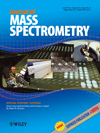
JOURNAL OF MASS SPECTROMETRY
Advancing the Frontiers of Mass Spectrometry ResearchThe Journal of Mass Spectrometry, published by Wiley, is a vital resource for researchers and professionals in the fields of chemistry and medicine. With an ISSN of 1076-5174 and an E-ISSN of 1096-9888, this journal specializes in the latest advancements in mass spectrometry, an essential analytical tool used in various applications including drug development, environmental monitoring, and biological research. Positioned in the Q3 quartile for both Medicine (miscellaneous) and Spectroscopy categories in 2023, the journal stands out for its commitment to disseminating high-quality research findings. Its Scopus ranking places it at 36th in the field of Chemistry _ Spectroscopy, within the 53rd percentile, reflecting its growing impact and relevance. Researchers are encouraged to submit their work and explore cutting-edge articles published between 1995 and 2024. Despite its non-open access model, the journal remains accessible through various academic platforms, fostering a rich exchange of knowledge among scientists worldwide.

Journal of Spectroscopy
Pioneering Research in the World of SpectroscopyJournal of Spectroscopy, published by HINDAWI LTD since 2009, is a renowned Open Access journal based in Egypt that serves as a valuable platform for the dissemination of cutting-edge research in the fields of analytical chemistry, atomic and molecular physics, and optics. With the unique ISSN 2314-4920 and E-ISSN 2314-4939, this journal aims to facilitate collaboration and knowledge exchange among researchers, professionals, and students by providing unrestricted access to essential findings and advancements. As of 2023, it holds a Q3 ranking in both Analytical Chemistry and Atomic and Molecular Physics, and a Q4 ranking in Spectroscopy, indicating its growing influence and relevance within the academic community. The journal also maintains a Scopus rank of #126 in Atomic and Molecular Physics and #53 in Spectroscopy, showcasing its commitment to high-quality scholarly content. With a converged timeline from 2013 to 2024, the Journal of Spectroscopy is positioned as a pivotal resource for the latest discoveries and innovative applications in spectroscopy-related studies.
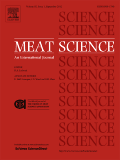
MEAT SCIENCE
Innovating for a Healthier Meat IndustryMEAT SCIENCE is a premier peer-reviewed journal dedicated to the exploration of the science of meat and meat products, contributing significantly to the fields of food science and technology. Published by Elsevier Science Ltd, this esteemed journal has been in circulation since 1977 and is recognized for its rigorous standards and impactful research, as evidenced by its Q1 category ranking in Food Science for 2023 and a notable 96th percentile ranking in Agricultural and Biological Sciences. The journal fosters innovative discussions and dissemination of cutting-edge research, covering a diverse range of topics including meat quality, safety, technology, and consumer preferences. With no open access options, MEAT SCIENCE caters to a dedicated audience of researchers, professionals, and students, serving as a vital resource for advancing knowledge and practices within the global meat industry. By continually pushing the boundaries of meat science, this journal plays a crucial role in shaping future research and industry standards.
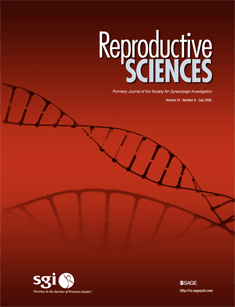
Reproductive Sciences
Innovative Insights for Obstetrics and GynecologyReproductive Sciences is a premier journal published by SPRINGER HEIDELBERG, dedicated to the field of obstetrics and gynecology. With its ISSN 1933-7191 and E-ISSN 1933-7205, the journal has established itself as a leading source of high-quality research and clinical insights since its inception in 2007, and continues to converge its scope into 2024. Currently ranked in the Q1 category for obstetrics and gynecology, it holds the 43rd position among 209 journals in the Scopus rankings, underscoring its influence and relevance within the medical community. This journal is particularly dedicated to advancing knowledge in reproductive health, providing a platform for innovative research and clinical practices through both traditional and open access options. Located in Switzerland with an address in Heidelberg, Germany, Reproductive Sciences is not just a publication; it is a vital resource for researchers, professionals, and students seeking to make impactful contributions to the field of reproductive health.

BioTech
Empowering Researchers Through Open Access KnowledgeBioTech is a forward-thinking academic journal published by MDPI, specializing in the dynamic fields of applied microbiology, biotechnology, biochemistry, bioengineering, and biomedical engineering. Established for promoting impactful research from 2021 to 2024, this journal aims to bridge the gap between laboratory findings and practical applications, serving as a vital resource for researchers, practitioners, and students alike. With its Open Access model, BioTech ensures that groundbreaking innovations are freely available to the global community, fostering collaboration and knowledge transfer across disciplines. In the 2023 rankings, BioTech holds a strong position in Q2 and Q3 quartiles across various categories, reflecting its commitment to high-quality research output. Being indexed in renowned databases, the journal enhances its visibility and reach, making it a preferred platform for sharing transformative ideas and discoveries in biotechnology and related domains. Set against the backdrop of Switzerland’s thriving research environment, BioTech is poised to become an essential resource in the rapidly evolving landscape of life sciences.

MICROSCOPY AND MICROANALYSIS
Navigating the Frontiers of MicroanalysisMICROSCOPY AND MICROANALYSIS is a prestigious academic journal published by Oxford University Press, specializing in the interdisciplinary fields of microscopy and microanalysis. With an ISSN of 1431-9276 and an E-ISSN of 1435-8115, this journal serves as a vital platform for the dissemination of high-quality research findings, innovative methodologies, and advancements in instrumentation techniques from its inception in 1995 to its ongoing contributions projected to 2024. As a Q3 ranked journal in the category of Instrumentation, it plays a crucial role in shaping the future of microscopy by providing researchers, professionals, and students with insights into cutting-edge technologies and applications. Although it does not currently offer open access, the journal remains committed to the academic community by maintaining rigorous peer-review standards and producing scholarly articles that are essential for advancing the understanding of materials at microscopic levels. By bridging the gap between theory and practical application, MICROSCOPY AND MICROANALYSIS is an indispensable resource for those involved in these dynamic scientific fields.
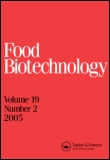
FOOD BIOTECHNOLOGY
Empowering Researchers in the Evolution of Food ScienceFOOD BIOTECHNOLOGY is an essential journal for those engaged in the rapidly evolving fields of food science, biotechnology, and applied microbiology. Published by Taylor & Francis Inc., this journal has been a prominent platform since its inception in 1987, with a convergence of insights expected to continue until 2024. With an ISSN of 0890-5436 and an E-ISSN of 1532-4249, it holds significant academic weight, reflected in its 2023 rankings which place it in the Q3 category for both Applied Microbiology and Biotechnology and Biotechnology, alongside a stronger Q2 classification in Food Science. Although it currently does not operate as an open-access journal, its contributions to food biotechnology are invaluable for researchers, professionals, and students alike, providing a rigorous peer-reviewed outlet for innovative studies that advance the understanding of food processing, safety, and biotechnological applications. The journal’s relevance is further underscored by its Scopus rankings, which position it within the top tiers of its respective categories, making it a critical resource for the scientific community aiming to pioneer advancements in food biotechnology.
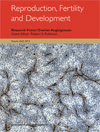
REPRODUCTION FERTILITY AND DEVELOPMENT
Advancing knowledge in reproductive science and developmental biology.Reproduction, Fertility and Development, published by CSIRO Publishing, is a prestigious journal that has been at the forefront of research in the fields of reproductive science, developmental biology, and related disciplines since its inception in 1989. With an ISSN of 1031-3613 and an E-ISSN of 1448-5990, this journal serves as a vital platform for disseminating innovative findings and methodologies that advance our understanding of reproductive processes and development in a variety of organisms. The journal is indexed in prominent databases, exhibiting a solid standing with a Q3 quartile ranking in both Animal Science and Zoology and Biotechnology, and covering 2023 rankings in multiple related categories. Operating from Australia, Reproduction, Fertility and Development embraces a commitment to enriching scholarly communication and fostering collaborative research efforts. Its focus on high-quality, peer-reviewed articles makes it an essential resource for researchers, professionals, and students seeking to stay abreast of the latest advancements and pivotal discussions in reproductive medicine and developmental biology.
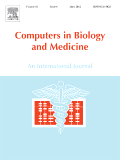
COMPUTERS IN BIOLOGY AND MEDICINE
Innovating Solutions at the Intersection of Biology and MedicineCOMPUTERS IN BIOLOGY AND MEDICINE is a prestigious academic journal published by Pergamon-Elsevier Science Ltd, dedicated to advancing the fields of Computer Science Applications and Health Informatics. With an impressive impact factor and ranking within the Q1 quartile for both categories, this journal plays a crucial role in disseminating high-quality research findings that influence cutting-edge developments at the intersection of computing and healthcare. Covering a broad range of topics from computational biology to medical informatics, it serves as a vital resource for researchers, professionals, and students striving to harness technology for medical advancements. The journal has been publishing since 1970 and continues to evolve, incorporating the latest trends and innovations in the field, thereby ensuring that it remains a key contributor to scientific inquiry and knowledge. With accessible content and a global reach, COMPUTERS IN BIOLOGY AND MEDICINE invites submissions that elevate the understanding and application of computational methods in biological and medical contexts.